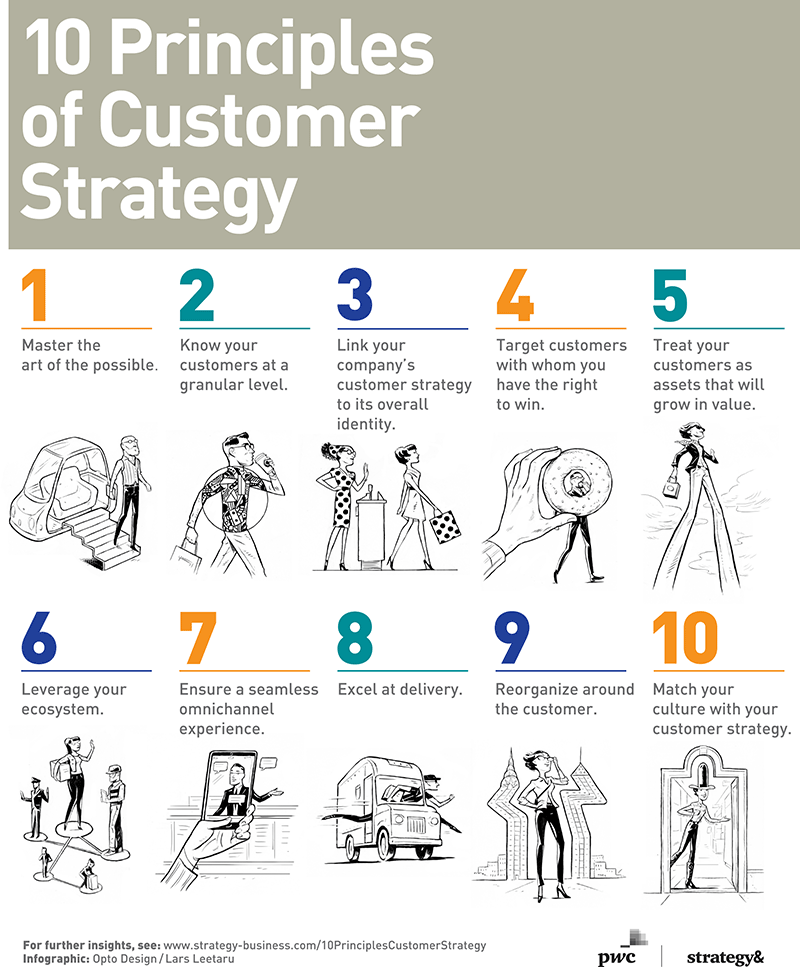Based on a recent global survey and interviews with key industry players, these 10 principles show how companies can position themselves for future customer success.

The conventional approach to gaining customers, based on picking a segment of purchasers to target and developing products for that segment, is no longer enough. A customer strategy goes further: It is the articulation of the distinctive value and experience your company will deliver to a chosen set of customers over three to five years, along with the offerings, channels, operating model, and capabilities you will need.
Ten principles at the heart of an effective customer strategy

1. Master the art of the possible. The most successful companies continually experiment with innovations that make life better for customers. That doesn’t mean asking your customers what they want; rather, you must develop your own informed judgment about what new technologies will appeal to your customers at just the right time, in just the right way, so that customers become more loyal to you. This is particularly important for digital and mobile technologies, which continue to fundamentally affect the ways people interact with the types of products and services they favor.
2. Know your customers at a granular level. Leading companies are moving beyond traditional quantitative segmenting. To raise your own customer analytics ability, thoroughly define your market and customers. Deepen your knowledge by applying techniques such as mapping the customer journey. Seek out data from a variety of sources at the most granular level; for example, activity tracked by the Internet of Things, real-time interactions with your own Web and e-commerce sites, social media, and online communities such as customer advocacy councils.
3. Link your company’s customer strategy to its overall identity. Every successful company has a strong value proposition that distinguishes it from rivals. To deliver this, it must develop and deploy a group of interrelated, distinctive capabilities. All of these must work together across the full portfolio of products and services. Linking your customer strategy to your company’s value proposition means aligning the emotional elements of your customer strategy, and all customer touch points including pricing, with the strongest capabilities your company has.
4. Target customers with whom you have the right to win. When your company has a strong identity, you don’t need to claim the right to compete in every marketplace — only in the categories where you are reasonably confident of winning against competitors. You can and should branch out to other customers and markets, but those new customers and markets should be reachable with the same capabilities that gave you an edge with your core base.
5. Treat your customers as assets that will grow in value. Building great customer relationships is a long-term game. It goes against many common practices, such as tracking the short-term return on customer acquisition investments. It even goes beyond quantifying the lifetime cost of a customer relationship, though that’s an important first step. You can build on this quantitative understanding by analyzing your customers’ paths to purchase, which will give you the insight you need to expand and tailor your customer relationships and to invest in meeting the evolving needs of your customers. The results of this analysis, particularly when customer data is included, can affect every aspect of your customer relationships, including the emotional attributes of your brand and the consistency of your pricing.
6. Leverage your ecosystem. Your company’s relationships extend to suppliers, distributors, retailers, industry associations, institutional partners, and government agencies. You can leverage this ecosystem to engage your customers in new ways. A broad ecosystem can reveal what else is of interest to your customers, opening up new ideas for product and service offerings and growth opportunities. Crucial to this approach is developing brand ambassadors. These advocates promote your brand to win over new consumers for you.
7. Ensure a seamless omnichannel experience. Consistency across channels will be critical during the next three to five years, because customers are getting to a point of taking it for granted. They expect to be able to hop between call centers, websites, mobile apps, retail stores, and sales calls, getting the same experience at each stop. This raises the bar for every part of the organization.
8. Excel at delivery. The physical delivery of products and services is critical to keeping your customers happy. You can tailor delivery options on the basis of margin, brand positioning, and customers’ value expectations — while staying in step with technological advances. The use of relevant metrics, including customer experience, cost, and productivity, can help ensure high-quality delivery without sacrificing profitability.
9. Reorganize around the customer. Your organization should be “fit for your customer”: designed to make it easy to deliver a great customer experience. Redesigning your organization might involve changing decision rights; shifting roles and responsibilities; establishing new teams; and aligning incentives, norms, and practices, always with your preferred customer groups and value proposition in mind. You may need to take the building blocks of your organizational DNA — the structures and processes of the existing company — and wire them differently.
10. Match your culture with your customer strategy. A relevant culture is a bigger advantage than ever for customer-facing companies. You might feel that your embedded cultural inhibitors hold you back. Don’t try to fix these problems directly; instead, focus on the few critical behaviors that exist in your organization in which people are doing well for customers. These might include mobilizing a cross-functional team to help a customer solve a problem quickly, saying no to a potential deal with a customer with whom you don’t have a right to win, or starting meetings by explicitly asking how it is relevant to the customer strategy. Then help spread these behaviors through the rest of the company.
Adapted and reprinted with permission from “10 Principles of Customer Strategy” from strategy+business. © 2016 PwC. All rights reserved.
About the Authors
Thomas Ripsam is an advisor to executives with Strategy&, PwC’s strategy consulting business. A principal with PwC US, he is based in Florham Park, N.J., where he leads the customer strategy team. Louis Bouquet is a thought leader with Strategy& based in New York. He is a director with PwC US. He focuses on customer strategy and transformation for technology clients.




